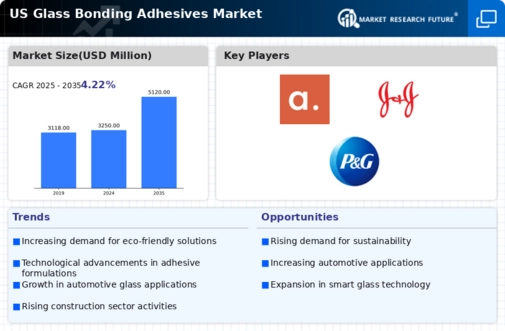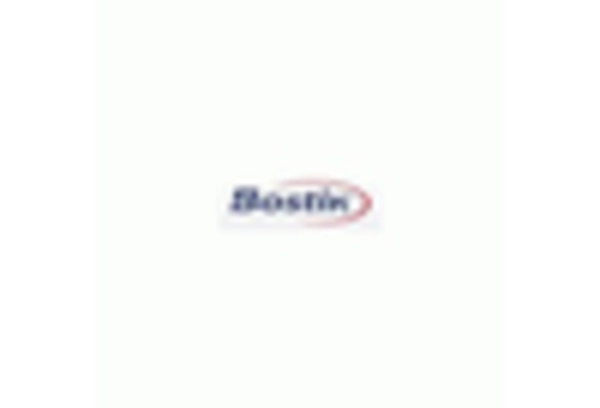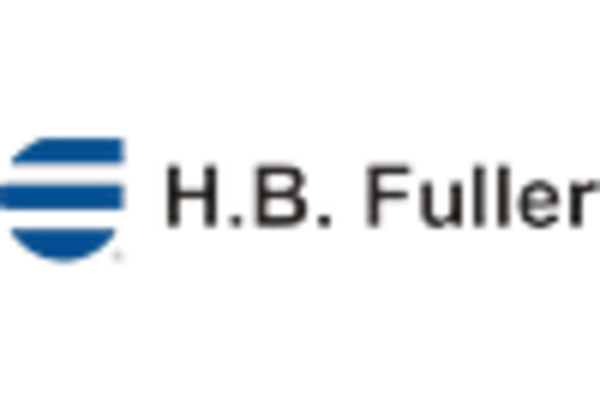Growth in Renewable Energy Sector
The renewable energy sector is experiencing rapid growth, which is positively impacting the glass bonding-adhesives market. With the rise of solar energy installations, there is an increasing need for adhesives that can bond glass components in solar panels effectively. In 2025, the renewable energy sector is expected to contribute significantly to the demand for glass bonding-adhesives, potentially accounting for around 15% of the market. This growth is driven by the push for sustainable energy solutions and the need for durable, weather-resistant adhesives that can withstand outdoor conditions. As the renewable energy sector continues to expand, the glass bonding-adhesives market is likely to see increased opportunities for growth, particularly in applications related to solar technology.
Rising Demand in Automotive Sector
The automotive industry is experiencing a notable surge in the use of glass bonding-adhesives, driven by the increasing incorporation of advanced glass technologies in vehicle manufacturing. As vehicles become more sophisticated, the need for high-performance adhesives that can withstand varying environmental conditions is paramount. In 2025, the automotive sector is expected to account for approximately 30% of the total demand for glass bonding-adhesives.. This trend is further fueled by the growing consumer preference for lightweight vehicles, which enhances fuel efficiency. Consequently, manufacturers are compelled to innovate and develop adhesives that not only bond glass effectively but also contribute to the overall structural integrity of vehicles. This rising demand in the automotive sector is a significant driver for the glass bonding-adhesives market, indicating a robust growth trajectory in the coming years.
Increased Focus on Aesthetic Appeal
The growing emphasis on aesthetic appeal in both residential and commercial spaces is significantly influencing the glass bonding-adhesives market. Architects and designers are increasingly opting for glass as a primary material due to its modern and sleek appearance. This trend is driving the demand for adhesives that not only provide strong bonding but also maintain the visual clarity of glass installations. In 2025, it is projected that aesthetic considerations will account for approximately 20% of the market demand for glass bonding-adhesives. As a result, manufacturers are focusing on developing clear, non-yellowing adhesives that enhance the overall look of glass applications. This increased focus on aesthetic appeal is a vital driver for the glass bonding-adhesives market, as it aligns with contemporary design trends and consumer preferences.
Expansion of Construction Activities
The construction industry in the US is witnessing a robust expansion, which is significantly impacting the glass bonding-adhesives market. With the increasing number of residential and commercial projects, the demand for high-quality adhesives that can bond glass in facades, windows, and interior applications is on the rise. In 2025, the construction sector is expected to account for around 25% of the overall market for glass bonding-adhesives.. This growth is attributed to the trend of using large glass panels for aesthetic and functional purposes, necessitating the use of specialized adhesives that ensure durability and safety. Furthermore, the emphasis on energy-efficient buildings is likely to drive the adoption of advanced bonding solutions that enhance thermal insulation properties. Thus, the expansion of construction activities serves as a crucial driver for the glass bonding-adhesives market.
Technological Innovations in Adhesive Formulations
Technological advancements in adhesive formulations are playing a pivotal role in shaping the glass bonding-adhesives market. Innovations such as the development of UV-curable adhesives and silicone-based products are enhancing the performance characteristics of bonding solutions. These advancements allow for faster curing times and improved adhesion properties, which are essential for various applications, including automotive and construction. In 2025, it is anticipated that technologically advanced adhesives will capture a significant share of the market, potentially exceeding 40%. This shift towards high-performance adhesives is driven by the need for products that can withstand extreme conditions, such as temperature fluctuations and moisture exposure. As manufacturers continue to invest in research and development, the glass bonding-adhesives market is likely to benefit from these technological innovations, leading to enhanced product offerings.

















Leave a Comment